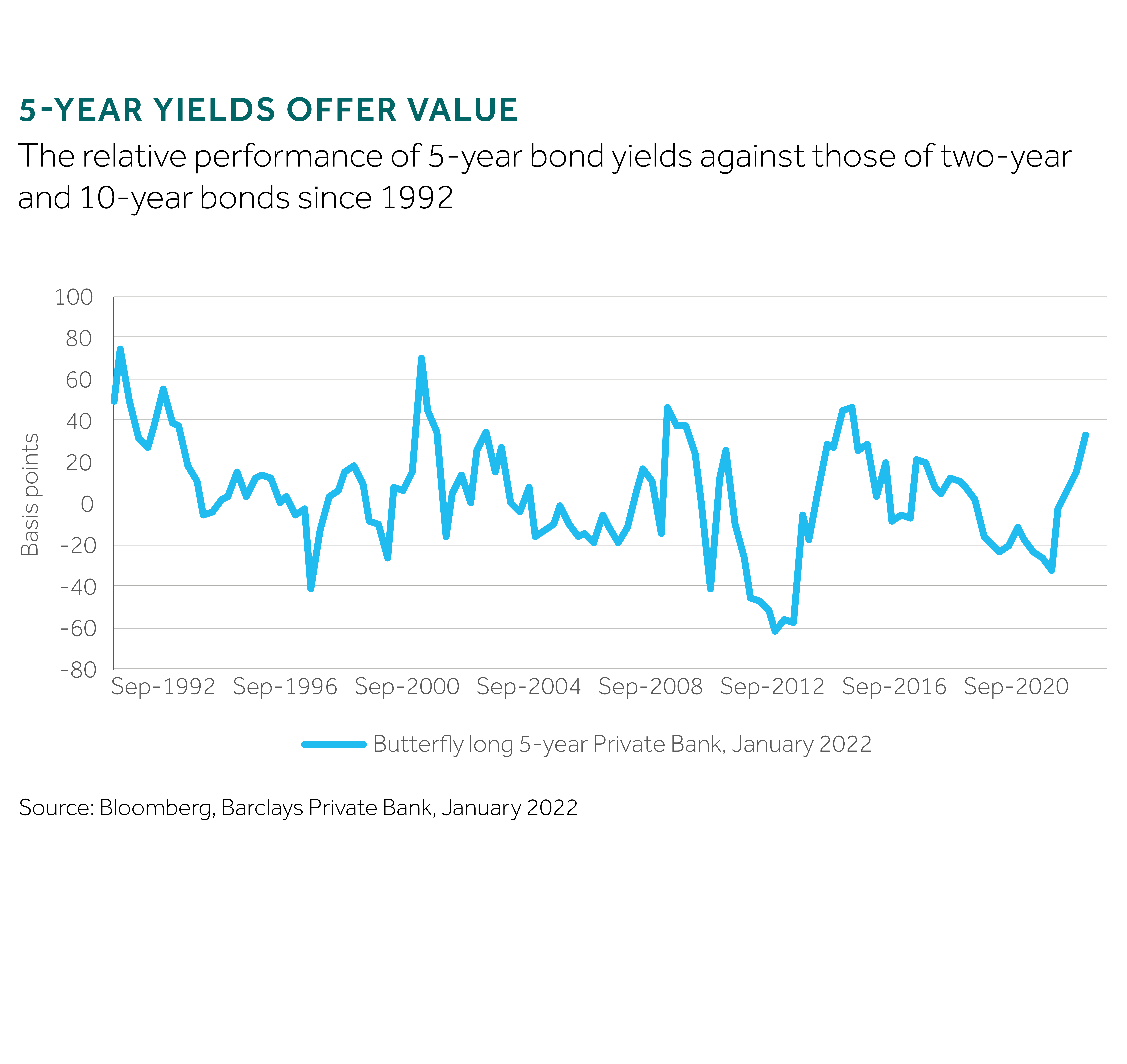Over an extended period, Fed chair, Jerome Powell, defended the policy of letting the economy run “hot”, to ensure a wide job market recovery among various income and ethnic groups. This narrative has changed now, as headline inflation remains above 5% for the eighth month.
“One of the two big threats to getting back to maximum employment is actually high inflation,” Powell said during a press conference . The tapering of current bond purchases is expected to be much quicker than had been expected, opening the door for a first hike in March.
Has our outlook changed for 2022?
In anticipation of the expected rate lift-off, the market has accelerated the flattening process with the two- and five-year point of the yield curve, moving them significantly upwards. A more determined Fed has provided more confidence that inflation can be tamed in the longer run. This increased confidence can be seen by lower trending inflation expectations, as the 10- year breakeven inflation rate consolidated from a 2.75% high to 2.45% in January. Is this the end-game, and what are the probable scenarios from here be?
Two essential questions for rates
The first question to be answered by the bond market concerns the timing of the lift-off, the number of rate hikes, and the likely end-point, or neutral long-term rate. The second question is what are the possible ramifications for the long end of the rate curve once the Fed starts to reduce its Treasury holdings?
Policy rate end-game
Listening to Jerome Powell and his colleagues, it seems that there is much uncertainty over the long-term neutral rate, that is the target policy rate that ensures full employment with inflation kept at bay. The Fed’s own “dot plot” forecasts suggest that the rate is 2.5%.
During recent decades, the long-term neutral rate has been revised down consistently, not least because of the disinflationary environment, but also higher systematic bond demand and positive global productivity growth rates. Such a narrative seems broken in the near term. That said, given the excessive wage growth and the prospect of lower bond demand in light of the upcoming balance-sheet reduction, a return towards the historical trend seems likely in the long term.
Gauging the pace of rate hikes
The Fed seems to acknowledge that accommodation must be more dynamic along the path towards the “end point”. This is very important, as a potential faster pace of rate hikes does not necessarily indicate a higher end-point.
Comments from Fed member Christopher Waller “If inflation is just stubbornly high through the first half of this year, we’re going to have to do a lot more,” would admittedly suggest a potential higher end-point. Indeed, Powell stated that “if we have to raise interest rates more over time, we will,” in front of the banking committee of the Senate in December.
But a wage growth spiral and commodity cycle is unlikely to run forever and the Fed, like many economists, expects a trend to more balanced supply and demand in the future. While many older workers (over 55 years of age) may not necessarily return to the workforce again, younger ones will do so eventually. Living from savings is not a perpetual game for most. This should ease some of the wage growth pressure.
The Fed is now trying to bridge the gap between a high inflationary period (how long it may last) and the period of lower inflation expected to follow. This separation could give Powell greater power to hike rates faster now. He said: “We would not in any way want to foreclose the idea that the labour market can get even better. But again, with inflation as high as it is we have to make policy in real time, we’ve got to make that assessment in real time.”
Surprises likely
With this in mind, three US rate hikes this year, as suggested by the Fed’s dot plot, seems to be very likely. A fourth increase, as implied by current market pricing, is possible, but not set in stone. The Fed will get inflation data for two more months ahead of the March FOMC meeting.
Higher persistent inflation may open up the potential for a surprise 50bp hike in March. This is not our base case, but only such a move would put a firmer cap on inflation expectations should breakeven yields, along with higher inflation readings in February and March, start to accelerate again. Such a move would potentially shift the rate curve higher, but may not necessarily mean a higher end point, as explained earlier.
Impact of a shrinking Fed balance sheet
In January, the FOMC stated that it “expects that reducing the size of the Federal Reserve’s balance sheet will commence after the process of increasing the target range for the federal funds rate has begun”. This implies that the reduction of the balance sheet may start in the first or second quarter of this year.
Given the strong recovery in the economy, and what could be defined as full employment, a balance sheet of over $8.7 trillion seems hardly justifiable. A run-off, as soon as July, seems more on the cards now. “The balance sheet is much bigger so the runoff can be faster.”, argued Powell.
Around $1.9 trillion of the Fed’s $5.6 trillion Treasury holdings mature in 2022 alone. The Fed would still reinvest a substantial portion of maturing debt to ensure a slower pace of runoff, potentially $15 billion to $30 billion a month to begin with, before a gradual increase towards $75 billion a month. This in turn could translate into a $1.2 trillion reduction by the end of 2023, or potentially $1.6 trillion if the runoff pace approaches $100 billion a month, $1.6 trillion which would need to be absorbed by private demand.


